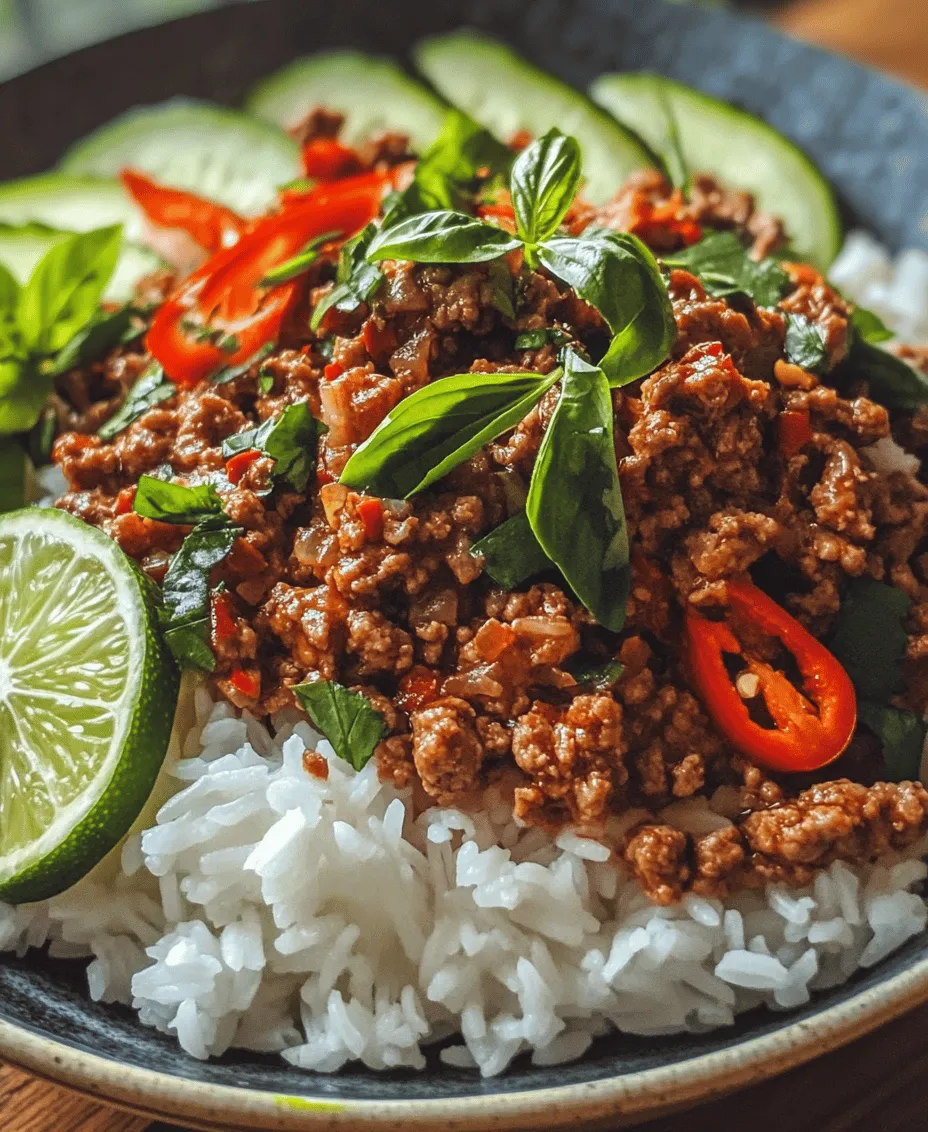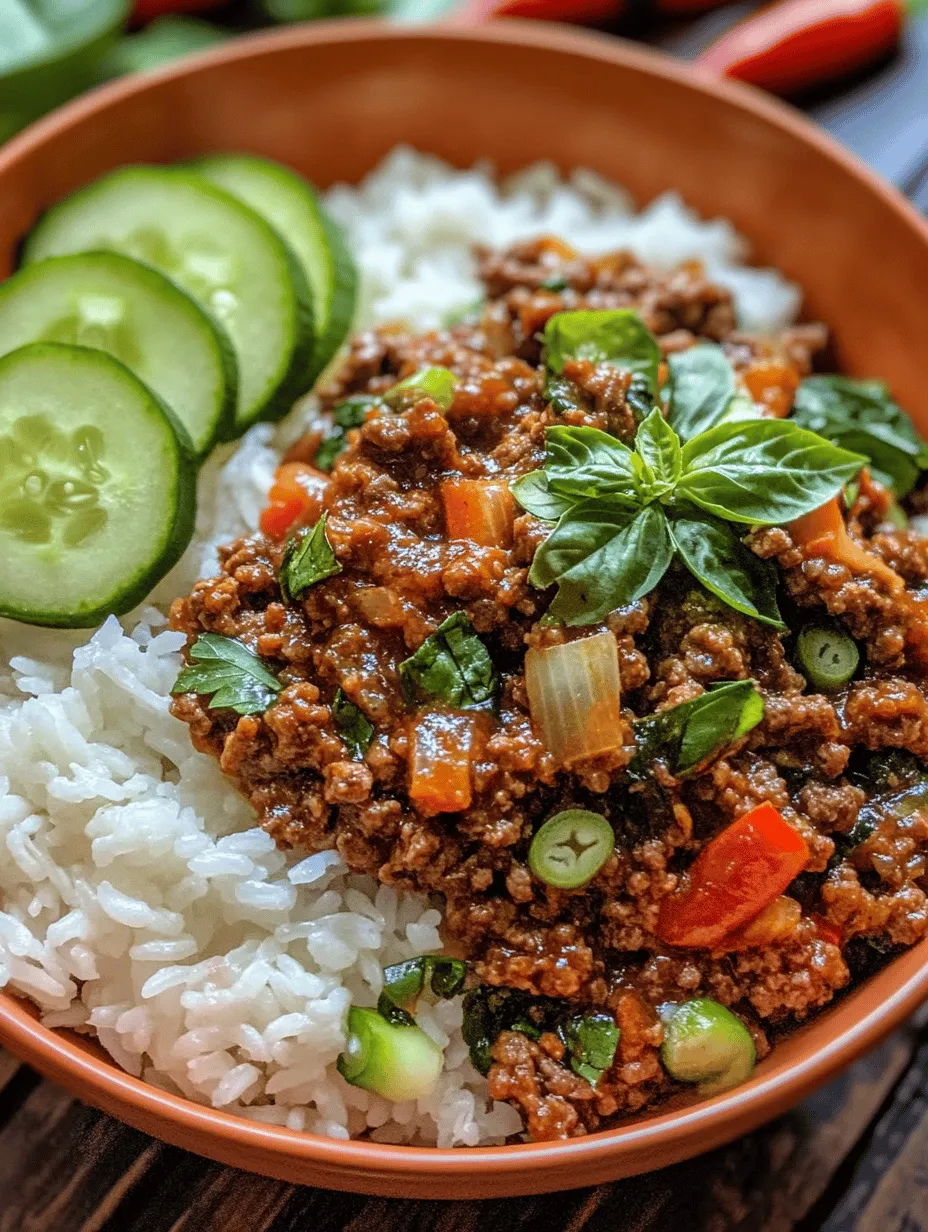Introduction
Thai cuisine is renowned for its vibrant flavors, aromatic herbs, and the perfect balance of sweet, sour, salty, and spicy elements. With its unique blend of ingredients and cooking techniques, Thai food has captured the hearts and palates of people around the world. One dish that stands out as a quintessential representation of this culinary tradition is Thai Basil Beef, or “Pad Krapow Neua.” This dish beautifully encapsulates the essence of Thai cooking, showcasing bold flavors and fresh ingredients that make it a favorite among food enthusiasts.
Thai Basil Beef is not just a dish reserved for special occasions; it is also a fantastic option for weeknight dinners, offering a quick and satisfying meal that can be prepared in under 30 minutes. The dish appeals to a wide range of eaters, thanks to its rich protein content, aromatic herbs, and an enticing blend of spices. The combination of tender ground beef stir-fried with fragrant Thai basil and a medley of savory sauces creates a delightful experience that is sure to please even the fussiest of eaters.
In this article, we’ll explore the origins of Thai Basil Beef, delve into its key ingredients, and provide a detailed breakdown of everything you need to create this mouthwatering dish at home. Get ready to take your taste buds on a flavorful journey that will transport you to the bustling streets of Thailand!
Understanding Thai Basil Beef
The origins of Thai Basil Beef can be traced back to the heart of Thailand, where it is a popular street food and home-cooked dish. It is often served with steamed jasmine rice and garnished with fresh vegetables, making it a complete meal that is both satisfying and nutritious. The dish embodies the Thai philosophy of balancing flavors and textures, with the savory ground beef complemented by the aromatic and slightly spicy notes of Thai basil.
At the core of Thai Basil Beef are its key ingredients, each playing a vital role in flavor development. Ground beef serves as the protein base, while the fresh Thai basil adds a unique herbal note that distinguishes this dish from other stir-fries. The combination of garlic, chilies, and various sauces contributes to a complex flavor profile that is both savory and satisfying.
One of the standout ingredients in this dish is fresh Thai basil. Unlike its Italian counterpart, which has a sweet and mild flavor, Thai basil has a more robust and peppery taste, with hints of anise and mint. This distinct flavor is essential to the dish, as it infuses the stir-fry with an aromatic quality that elevates the overall experience. The use of fresh herbs is a hallmark of Thai cooking, and Thai basil is no exception—it brings not only flavor but also a vibrant green color that enhances the presentation of the dish.
Ingredient Breakdown
Creating the perfect Thai Basil Beef requires an understanding of each ingredient’s role and how they come together to create a harmonious dish. Let’s break down the essential components you’ll need:
Ground Beef
Ground beef is the primary protein source in Thai Basil Beef, providing the dish with its hearty and filling nature. This ingredient is rich in protein and essential nutrients, making it an excellent choice for a balanced meal. When selecting ground beef, opt for high-quality meat with a good fat-to-lean ratio, typically around 80/20. This balance ensures that the beef remains juicy and flavorful during cooking. Look for fresh, bright red meat with minimal browning, indicating freshness.
Fresh Thai Basil
Fresh Thai basil is perhaps the most important ingredient in this dish, as it defines the flavor profile of Thai Basil Beef. This variety of basil has a distinct aroma and taste, characterized by its spicy and slightly sweet notes, which set it apart from regular sweet basil. When purchasing Thai basil, select vibrant green, unblemished leaves, and avoid any wilted or yellowing parts. To store fresh Thai basil, wrap it in a damp paper towel and place it in a plastic bag in the refrigerator. Alternatively, you can place the stems in a glass of water and cover the leaves with a plastic bag to keep them fresh for longer.
Garlic and Chilies
Garlic is a foundational ingredient in many Thai dishes, including Thai Basil Beef. Its pungent and aromatic qualities enhance the overall flavor, bringing depth to the dish. Fresh garlic should be minced finely or smashed to release its oils and flavors effectively.
Thai chilies are essential for adding heat to the dish. Depending on your spice tolerance, you can adjust the number of chilies used. These small, vibrant red or green peppers pack a punch, and their heat level can vary. For a milder flavor, you can remove the seeds before adding them to the stir-fry.
Sauces and Seasonings
The sauces and seasonings are crucial in developing the umami flavor that Thai Basil Beef is known for. A combination of soy sauce, oyster sauce, fish sauce, and a touch of sugar creates a savory and slightly sweet sauce that coats the beef and vegetables beautifully.
– Soy Sauce: This is the base for many Asian dishes, providing a salty and rich flavor.
– Oyster Sauce: Adds a deep, savory taste with a hint of sweetness, enhancing the dish’s complexity.
– Fish Sauce: A staple in Thai cuisine, fish sauce provides a unique umami flavor and a hint of saltiness.
– Sugar: A small amount of sugar balances the saltiness of the sauces and rounds out the flavors.
Jasmine Rice
To complement the bold flavors of Thai Basil Beef, jasmine rice is the perfect accompaniment. This fragrant, long-grain rice has a slightly sticky texture when cooked, making it ideal for soaking up the flavorful sauce. Cooking jasmine rice is simple; rinse the rice under cold water to remove excess starch, then cook it in a ratio of 1 part rice to 1.5 parts water. Bring to a boil, then reduce the heat to low, cover, and simmer until the rice is tender and fluffy.
Garnishes
Garnishing your Thai Basil Beef is essential for both presentation and taste. Cucumber slices and lime wedges add a refreshing crunch and a burst of acidity that balances the richness of the beef. Including these garnishes not only enhances the visual appeal of the dish but also provides an opportunity for diners to customize their flavor experience.
With a clear understanding of the ingredients and their significance, you’re well on your way to preparing a delicious Thai Basil Beef with Rice. In the next section, we will dive into the detailed instructions for cooking this mouthwatering dish, ensuring you achieve the perfect balance of flavors and textures. Prepare to bring a taste of Thailand to your kitchen!

Step-by-Step Instructions for Thai Basil Beef with Rice
Cooking the Rice
To create the perfect base for your Thai Basil Beef, start with jasmine rice, renowned for its fragrant aroma and slightly sticky texture. Here’s how to achieve the best results:
1. Rinse the Rice: Begin by measuring out one cup of jasmine rice. Place the rice in a fine-mesh strainer and rinse it thoroughly under cold water. This step is crucial because it removes excess starch, preventing the rice from becoming gummy during cooking.
2. Soaking (optional): For an extra fluffy texture, consider soaking the rinsed rice in water for about 30 minutes. This allows the grains to absorb some water, leading to a more even cooking process.
3. Cooking the Rice: Transfer the rinsed (and optionally soaked) rice to a pot and add one and a half cups of water. Bring the mixture to a boil over medium-high heat. Once boiling, reduce the heat to low, cover the pot with a lid, and let it simmer for about 15 minutes. Avoid lifting the lid, as this can release steam and affect cooking.
4. Fluffing the Rice: After the cooking time has elapsed, turn off the heat and let the rice sit, covered, for an additional 10 minutes. This resting period allows the rice to steam in its own heat. Finally, remove the lid and use a fork to fluff the rice gently. This step is essential for achieving that light, airy texture that complements your beef perfectly.
Preparing the Beef Mix
The next step is to prepare the beef mix, which involves building layers of flavor through proper sautéing techniques.
1. Sautéing Aromatics: In a large skillet or wok, heat two tablespoons of vegetable oil over medium heat. Once hot, add three minced garlic cloves and one finely chopped red chili (adjust according to your heat preference). Stir-fry these ingredients for about 30 seconds, or until fragrant. Be cautious not to burn the garlic, as it can turn bitter and ruin the dish.
2. Timing for Flavor: The goal is to release the aromatic oils in the garlic and chili without letting them brown too much. Keep an eye on your heat level; if it’s too high, reduce it slightly to maintain control over the cooking process.
Cooking the Beef
Now it’s time to cook the beef, which is the star of this dish.
1. Browning the Beef: Add one pound of ground beef to the skillet, breaking it apart with a spatula. Spread it out evenly in the pan to ensure it browns uniformly. Avoid overcrowding the pan, as this can lead to steaming rather than browning. If necessary, cook in batches to achieve that golden color.
2. Cooking Time: Allow the beef to cook without stirring for the first few minutes. This helps the meat develop a nice sear. Once browned, stir and continue to cook until the beef is no longer pink, about 5-7 minutes.
Adding the Sauce
With the beef perfectly cooked, it’s time to introduce the sauce that ties all the flavors together.
1. Mixing the Sauces: In a small bowl, combine three tablespoons of soy sauce, one tablespoon of oyster sauce, one tablespoon of fish sauce, and one tablespoon of sugar. This blend provides a perfect balance of savory, sweet, and umami flavors.
2. Incorporating the Sauce: Pour the sauce over the browned beef, stirring well to coat the meat evenly. Allow the mixture to simmer for about 2-3 minutes, letting the beef absorb the flavors. Monitor the cooking time to prevent the sauce from evaporating too much; you want it to remain flavorful and saucy.
Incorporating Basil
At this point, it’s essential to add the basil, which gives the dish its distinct flavor.
1. Adding Fresh Basil: Remove the pan from the heat and fold in one cup of fresh Thai basil leaves. Gently mix the basil into the beef mixture, ensuring the leaves are coated but not overcooked. This helps retain the vibrant green color and fresh flavor of the basil.
2. Serving Immediately: Thai Basil Beef is best served immediately while the basil is still bright and fresh.
Serving Suggestions
Presentation is key to enhancing the dining experience, and there are several ways to serve Thai Basil Beef with Rice.
1. Plate the Dish: Serve a generous portion of jasmine rice on one side of the plate, topped with the flavorful Thai Basil Beef. This creates a beautiful contrast between the white rice and the colorful beef mixture.
2. Garnishing for Appeal: To elevate the dish, consider garnishing with additional fresh basil leaves or thinly sliced red chilies. Not only does this add visual appeal, but it also enhances the flavor profile.
3. Accompaniments: For a complete meal, you might serve Thai Basil Beef with a side of stir-fried vegetables or a light cucumber salad. The freshness of the salad will balance the rich flavors of the beef.
Nutritional Information
Thai Basil Beef with Rice is not only delicious but also offers a range of nutritional benefits. Here’s a rough breakdown of the nutritional information per serving:
– Calories: Approximately 450-500 calories
– Protein: 25-30 grams (depending on the leaness of the beef)
– Fats: 20-25 grams
– Carbohydrates: 50-55 grams
Dietary Adjustments
For those looking to make this dish healthier or accommodate dietary needs, consider the following adjustments:
– Using Lean Beef: Opt for lean ground beef (like 90% lean) to reduce fat content while still enjoying the rich flavors.
– Vegetarian Alternatives: Substitute the beef with ground tofu or tempeh for a vegetarian version that maintains the original flavors.
– Gluten-Free Options: Ensure your soy sauce is gluten-free if you are accommodating dietary restrictions.
Cultural Significance of Thai Basil Beef
Thai Basil Beef, or “Pad Krapow Beef,” is not just a popular dish; it holds a significant place in Thai culture.
1. Role in Thai Cuisine: This dish exemplifies the harmonious balance of flavors that Thai cuisine is renowned for—sweet, salty, spicy, and savory. The use of fresh herbs like Thai basil is a hallmark of traditional Thai cooking, contributing to the aromatic profile of the dish.
2. Dining Experience: In Thailand, Pad Krapow is often enjoyed as street food, served with a fried egg on top and accompanied by jasmine rice. This casual dining experience reflects the communal aspect of Thai meals, where sharing and enjoying food together is a cherished tradition.
3. Global Popularity: Thai Basil Beef has transcended borders and is now a favorite in Thai restaurants worldwide. Its straightforward preparation and vibrant flavors make it accessible and appealing to many culinary enthusiasts.
Conclusion
Thai Basil Beef with Rice is a delightful dish that combines simplicity with rich, authentic flavors. With a few straightforward steps, you can create a meal that tantalizes the taste buds and transports you to the streets of Thailand.
Encouragement is given to those who wish to try this recipe at home to experience the joy of cooking and the rewarding flavors of Thai cuisine. Whether you stick to the traditional preparation or customize it to your tastes, Thai Basil Beef has the versatility to become a staple in your kitchen. Enjoy creating and sharing this culinary gem with family and friends, and relish the satisfaction of serving a dish that’s not only delicious but steeped in cultural significance.



